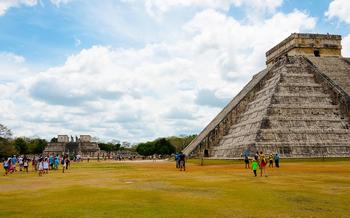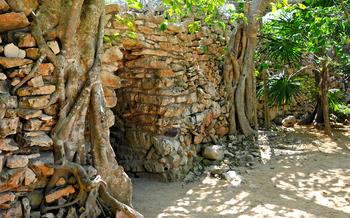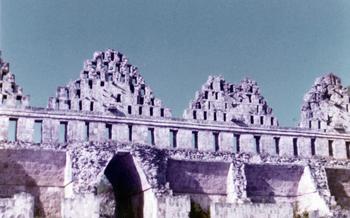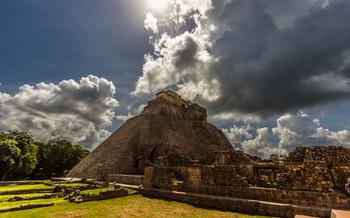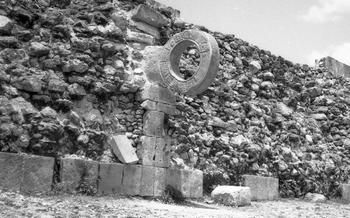
Temple of the Dolls, Dzibilchaltun
- A Journey to Uxmal: Unveiling the Mayan Legacy
- The Temple of the Dolls: A Sanctuary for Ancient Rituals
- Exploring the Grand Plaza: A Walk Through History
- The Pyramid of the Magician: A Testament to Mayan Ingenuity
- The Nunnery Quadrangle: A Realm of Secrets
- The House of the Turtles: A Glimpse into Ancient Astronomy
- The Ball Court: A Stage for Ritual and Competition
- The Temple of the Birds: A Symbol of Divine Connection
- The Great Pyramid: A Majestic Symbol of Power
- The Temple of the Old Woman: A Mysterious Edifice
- The Cenote Xlacah: A Sacred Water Source
- The Dzibilchaltun Ruins: A Glimpse into an Ancient City
- The Temple of the Seven Dolls: A Place of Offerings
- The Cenote Xkeken: A Natural Wonder
- Insider Tip: The Best Time to Visit Uxmal
A Journey to Uxmal: Unveiling the Mayan Legacy
Uxmal, a UNESCO World Heritage Site, stands as a testament to the grandeur and ingenuity of the ancient Mayan civilization. Its well-preserved ruins transport visitors back in time, offering a glimpse into the lives and beliefs of this enigmatic people.
Must-know facts for an enriching visit:
- Uxmal was once a thriving metropolis, home to over 25,000 Mayans.
- The site is divided into several sections, each with its own unique structures and features.
- The best time to visit Uxmal is during the dry season (November to April) when the weather is pleasant and sunny.
- Visitors should wear comfortable shoes as they will be doing a lot of walking.
- It's advisable to bring a hat, sunscreen, and plenty of water to stay hydrated.
Tips for planning your trip to Uxmal:
- Allow at least half a day to explore the ruins properly.
- Guided tours are available and highly recommended for a deeper understanding of the site.
- Photography is permitted, but using a tripod is not allowed inside the ruins.
- There are several restaurants and shops near the entrance where visitors can grab a bite to eat or buy souvenirs.
Anecdote about a memorable experience in Uxmal:
During my visit to Uxmal, I was particularly struck by the Pyramid of the Magician. As I climbed the steep steps, I couldn't help but feel a sense of awe and wonder. The view from the top was breathtaking, and I could see for miles across the jungle canopy. It was a truly unforgettable experience that left me with a deep appreciation for the ingenuity and legacy of the ancient Mayans.
The Temple of the Dolls: A Sanctuary for Ancient Rituals
The Temple of the Dolls, also known as the House of the Doves, is a captivating structure located within the archaeological zone of Uxmal. This temple holds a particular significance in Mayan history, as it served as a sanctuary for ancient rituals and ceremonies.
Constructed during the Late Classic period (600-900 AD), the Temple of the Dolls showcases intricate carvings and sculptures that depict an array of deities, mythical creatures, and scenes from everyday life. The temple's facade is adorned with hundreds of small clay dolls, believed to represent the rain god Chaac. These dolls lend the temple its name and are thought to have been offerings made by devotees seeking divine favor.
One of the most striking features of the Temple of the Dolls is its well-preserved interior. Inside, visitors can admire a series of chambers and passageways, each adorned with unique carvings and paintings. The temple's main chamber features a large platform, likely used for conducting rituals and ceremonies.
Myths and legends surrounding the Temple of the Dolls add to its mystique. According to one legend, the temple was once home to a beautiful princess who was transformed into a dove by a powerful sorcerer. The dolls are said to represent the princess's tears, which turned into clay figures as they fell to the ground.
During my visit to the Temple of the Dolls, I couldn't help but be captivated by its beauty and the stories that surround it. As I stood before the temple, I imagined the ancient Mayans performing their rituals and ceremonies, seeking blessings from the gods and offering their prayers to the heavens. The Temple of the Dolls is a testament to the rich cultural and religious heritage of the ancient Mayan civilization.
Exploring the Grand Plaza: A Walk Through History
The Grand Plaza, the heart of Uxmal, is a sprawling expanse that showcases the city's grandeur and architectural finesse. Surrounded by towering pyramids, temples, and palaces, it was once the stage for bustling markets, religious ceremonies, and social gatherings.
The plaza's centerpiece is the Governor's Palace, an awe-inspiring structure that served as the administrative and residential complex for Uxmal's rulers. Its intricate facade, adorned with intricate carvings and colorful murals, narrates tales of the city's history and mythology.
Another notable structure is the Temple of the Magician, a towering pyramid that dominates the plaza's western end. Its unique architectural style and enigmatic history continue to captivate visitors and fuel speculations about its purpose.
As the sun begins its descent, the Grand Plaza transforms into a magical realm bathed in golden light. The shadows of the pyramids lengthen, casting an ethereal glow on the ancient stones. This is the perfect time to wander through the plaza, marveling at the architectural wonders and soaking in the tranquil atmosphere.
One evening, as I stood in the center of the Grand Plaza, I witnessed a breathtaking sunset that painted the sky in vibrant hues of orange, pink, and purple. The ancient structures cast long, dramatic shadows across the plaza, creating an ethereal and awe-inspiring scene. It was a moment that reminded me of the enduring power and beauty of Uxmal, a city that continues to enchant and inspire travelers from around the world.
The Pyramid of the Magician: A Testament to Mayan Ingenuity
Standing tall and proud in the heart of Uxmal, the Pyramid of the Magician, also known as the Pyramid of the Dwarf, is a testament to the architectural prowess and ingenuity of the ancient Mayans. This towering structure, named after a legendary Mayan ruler, is one of the most iconic landmarks of the site. Its unique features and rich history make it a must-see for any visitor to Uxmal.
History and Significance:
- The Pyramid of the Magician was built between the 6th and 10th centuries AD, during the height of the Mayan civilization.
- It is believed to have been a ceremonial center and a place of worship, dedicated to the Mayan rain god Chaac.
- The pyramid was constructed using the corbelled arch technique, a method of stacking stones without the use of mortar.
- Its name, "Pyramid of the Magician," is derived from a local legend that attributes its construction to a dwarf magician who possessed supernatural powers.
Architectural Wonders and Unique Features:
- The Pyramid of the Magician is the tallest structure in Uxmal, rising to an impressive height of 115 feet.
- It has a square base and a steep, stepped profile, with nine levels leading to a small temple at the top.
- The pyramid's exterior is adorned with intricate carvings and sculptures, depicting various Mayan deities and mythical creatures.
- The most notable feature of the pyramid is its elaborate facade, which features a series of masks representing the rain god Chaac.
- The pyramid's interior contains a series of chambers and passageways, which were likely used for religious rituals and ceremonies.
The Legend of the Pyramid's Construction:
- According to Mayan legend, the Pyramid of the Magician was built by a dwarf magician named Itzamna in a single night.
- Itzamna is said to have used his magical powers to transport the stones from a distant quarry to the construction site.
- The legend also tells of a beautiful princess who was sacrificed at the top of the pyramid to appease the rain god Chaac.
- The pyramid's construction is a testament to the Mayans' advanced engineering skills and their deep connection to their religious beliefs.
The Nunnery Quadrangle: A Realm of Secrets
Amidst the bustling ruins of Uxmal lies the Nunnery Quadrangle, a complex steeped in mystery and intrigue. While its exact purpose remains debated among scholars, its architectural splendor and captivating aura are undeniable. Constructed around a central courtyard, the quadrangle comprises several buildings, each adorned with intricate carvings and bas-reliefs.
Among the highlights of the Nunnery Quadrangle are the East and West Buildings, which showcase exquisitely preserved friezes and masks representing Mayan deities. The North Building, with its vaulted ceilings and colonnades, exudes an air of tranquility, inviting visitors to contemplate the secrets whispered within its walls.
Theories abound regarding the function of the Nunnery Quadrangle. Some believe it served as a residence for high-ranking priestesses or nuns, while others suggest it was a school or a ceremonial center. The absence of domestic features, such as kitchens or hearths, has fueled speculation that it may have had a more spiritual or ritualistic purpose.
One intriguing theory posits that the Nunnery Quadrangle was used for astronomical observations. The alignment of the buildings with celestial events, such as solstices and equinoxes, suggests that the ancient Maya possessed a sophisticated understanding of the cosmos.
As you wander through the Nunnery Quadrangle, let your imagination soar. Picture the Maya women who once walked these grounds, their voices echoing in the stillness. Feel the energy of ancient rituals and ceremonies that may have taken place within these walls. The Nunnery Quadrangle is a place where history and mystery intertwine, inviting you to unravel its secrets and connect with the past.
In a personal anecdote, I recall a visit to the Nunnery Quadrangle during the soft glow of twilight. As the sun cast long shadows across the courtyard, I felt a sense of profound connection with the ancient Maya. It was as if the spirits of the past were whispering their stories to me, revealing the secrets that had been hidden for centuries.
The House of the Turtles: A Glimpse into Ancient Astronomy
Amidst the sprawling ruins of Uxmal, the House of the Turtles stands as a testament to the ancient Maya's profound understanding of astronomy. Constructed during the Late Classic period, this building served as an astronomical observatory, allowing the Maya priests to track the movements of celestial bodies and predict important events.
The most striking feature of the House of the Turtles is its unique roofline, which resembles the shell of a turtle. This design is not merely decorative; it serves a specific astronomical purpose. The building's windows are aligned with the cardinal directions, allowing sunlight to enter the building at specific times of the year. By observing these patterns, the Maya priests could determine the solstices, equinoxes, and other significant astronomical events.
The House of the Turtles also features several other architectural elements that suggest its astronomical significance. The building's interior is divided into two chambers, each with its own unique features. The eastern chamber contains a series of niches that may have been used to store astronomical instruments. The western chamber has a large window that frames the sunset during the spring and fall equinoxes.
The Maya's fascination with astronomy was not simply a matter of curiosity; it had a practical purpose. By understanding the movements of the stars and planets, the Maya could predict the changing seasons, which was crucial for agriculture. They could also use astronomical observations to create calendars and plan religious ceremonies.
Visiting the House of the Turtles is a truly awe-inspiring experience. As you stand beneath its ancient roof, you can't help but feel a sense of wonder at the Maya's incredible knowledge and ingenuity. This building is a reminder that even in the most ancient of times, humans were capable of great intellectual achievements.
Personal Anecdote:
During my visit to Uxmal, I had the opportunity to witness a breathtaking astronomical event from the House of the Turtles. I arrived at the site just before sunset and positioned myself in the western chamber. As the sun slowly descended towards the horizon, I watched in amazement as its rays perfectly aligned with the large window, creating a mesmerizing display of light and shadow. It was a truly magical moment, and I felt a deep connection to the ancient Maya astronomers who had stood in the same spot centuries before me.
The Ball Court: A Stage for Ritual and Competition
Amidst the awe-inspiring ruins of Uxmal, the ball court stands as a testament to the Mayans' athletic prowess and deep spiritual beliefs. This ancient arena, measuring an impressive 115 meters in length, was not merely a sports ground but a sacred space where rituals, competitions, and social interactions intertwined.
The ball game, known as Pok-ta-Pok, held immense significance in Mayan culture. It was more than just a game; it was a ritual that symbolized the struggle between light and darkness, fertility and barrenness, and the cyclical nature of life and death. The rules were complex, involving teams using their hips, elbows, and knees to keep a solid rubber ball in play without using their hands.
The architectural features of the ball court are as captivating as the game itself. The sloping walls, with their intricate carvings and bas-reliefs depicting scenes of the game, create an immersive atmosphere. The acoustics are such that even a whisper can be heard from one end of the court to the other.
Visiting the ball court in Uxmal is a truly immersive experience. As you stand on the sidelines, you can almost hear the echoes of the ancient players, feel the tension of the game, and sense the spiritual significance that permeated every aspect of this sacred space.
The Temple of the Birds: A Symbol of Divine Connection
The Temple of the Birds, or Templo de los Pájaros, stands as a testament to the Mayans' deep spiritual connection with the natural world. Constructed in the 9th century, this intricately decorated temple played a significant role in religious ceremonies and rituals centered around the worship of the bird deity Itzamná.
Adorned with exquisite carvings and bas-reliefs depicting various bird species, the temple's facade exudes an air of elegance and reverence. Mythical creatures, such as the long-tailed quetzal bird, considered a symbol of the god Kukulkan, adorn the temple's exterior, creating a sense of awe and wonder.
Inside the temple, a series of chambers and passageways unfolds, each adorned with vibrant murals and sculptures that depict scenes from Mayan mythology and religious ceremonies. These elaborate artworks offer a glimpse into the rich spiritual beliefs and practices of the ancient Maya civilization.
As the sun casts its golden rays upon the temple, the intricate carvings and bas-reliefs come alive, creating a magical play of light and shadow that enhances the temple's sacred ambiance. It is during these moments that visitors can truly feel the profound connection between the Mayans and the divine forces they revered.
In the heart of the temple, a small altar stands as a reminder of the offerings and rituals that once took place within these sacred walls. Here, the Mayans would present their prayers and offerings to the bird deities, seeking their blessings and guidance in various aspects of life.
Standing before the Temple of the Birds, one cannot help but feel a sense of awe and reverence for the deep spiritual connection that the Mayans shared with the natural world. This temple stands as a testament to their profound respect for the sacredness of life and their belief in the divine power of the avian realm.
The Great Pyramid: A Majestic Symbol of Power
The Great Pyramid, also known as the Pyramid of the Governor, stands as a testament to the architectural prowess of the ancient Maya. Its imposing structure dominates the skyline of Uxmal, beckoning visitors to unravel its secrets. As I approached the pyramid, its sheer size filled me with awe. Its towering height and massive base exuded an aura of grandeur that left me speechless.
The pyramid's exterior showcases intricate carvings and sculptures that depict various Mayan deities and mythical creatures. Each stone seemed to narrate a story, inviting me to delve deeper into the rich history and culture of this ancient civilization. The pyramid's four sides are adorned with steep staircases that lead to the summit, where a small temple once stood.
Climbing the pyramid was a challenging but rewarding experience. With each step, I felt a connection to the ancient Maya who had built this magnificent structure centuries ago. The view from the top was breathtaking. The lush green surroundings, dotted with other Mayan ruins, stretched out before me, creating a panoramic vista that left me in awe.
Exploring the interior of the pyramid was an adventure in itself. Narrow passageways and hidden chambers revealed intricate murals and artifacts that provided glimpses into the lives of the Maya who once inhabited this city. The Great Pyramid stands as a symbol of the Maya's architectural achievements, a testament to their ingenuity and their deep connection to the divine.
The Temple of the Old Woman: A Mysterious Edifice
Amidst the grandeur of Uxmal's sprawling ruins, the Temple of the Old Woman stands as an enigmatic monument, shrouded in mystery and intrigue. Its origins are uncertain, and its purpose remains a subject of debate among scholars. The temple's unique architectural features, including its unusual rounded corners and intricate carvings, set it apart from other structures in the city.
Architectural Distinctiveness:
The Temple of the Old Woman showcases a unique blend of architectural styles, combining Puuc and Chenes elements. Its rounded corners, a rare feature in Mayan architecture, suggest a possible influence from the Gulf Coast region. The temple's facade is adorned with intricate carvings depicting human figures, animals, and geometric patterns, showcasing the artistry and skill of the ancient Maya.
Unveiling Theories:
The exact purpose of the Temple of the Old Woman is still a mystery. Some theories suggest that it may have been a temple dedicated to a specific deity, possibly an ancient goddess associated with childbirth or fertility. Others believe it may have served as a residential palace or an administrative building. The temple's proximity to the Nunnery Quadrangle, a complex believed to have been inhabited by women, lends credence to these theories.
An Encounter with the Unknown:
As I stood before the Temple of the Old Woman, a sense of awe and curiosity washed over me. The enigmatic aura surrounding the structure drew me closer, and I couldn't resist the urge to explore its hidden corners. As I ventured inside, I felt a strange presence, as if the temple's ancient spirits were watching my every move. The silence was deafening, broken only by the faint rustling of the wind through the trees.
Leaving with Questions:
As I reluctantly left the Temple of the Old Woman, my mind was abuzz with unanswered questions. The mystery of its purpose and the stories it held within captivated me. Uxmal's ruins continued to reveal their secrets, and I knew that my journey of discovery was far from over.
The Cenote Xlacah: A Sacred Water Source
The Cenote Xlacah, located a short distance from the Uxmal ruins, holds a special place in Mayan history and culture. This natural wonder, formed by the collapse of a limestone cave, served as a vital water source for the ancient city. Its crystal-clear waters, surrounded by lush vegetation, created a sacred and tranquil space for the Mayans.
Geological Formation and Unique Features
The Cenote Xlacah is a sinkhole cenote, formed when the roof of an underground cavern collapsed due to the gradual erosion of the limestone bedrock. The resulting circular depression, known as a cenote, exposes the groundwater table, creating a natural pool of fresh water. The Cenote Xlacah is approximately 100 feet in diameter and 60 feet deep, with sheer walls that drop down to the water's surface.
Mayan Rituals and Beliefs Associated with Cenotes
Cenotes, like the Cenote Xlacah, held profound religious and cultural significance for the ancient Mayans. They believed that cenotes were gateways to the underworld, known as Xibalba, and were considered sacred portals for communication with the gods. The Mayans performed various rituals and ceremonies at cenotes, including offerings, prayers, and sacrifices. They believed that throwing precious objects, such as jade, gold, and pottery, into the cenote would appease the gods and bring good fortune.
Personal Account: A Swim in the Sacred Waters
During my visit to Uxmal, I had the opportunity to experience the magic of the Cenote Xlacah firsthand. As I descended the stone steps leading to the water's edge, I was struck by the serene atmosphere and the crystal-clear reflection of the surrounding vegetation on the surface. The water was refreshingly cool and inviting, and I couldn't resist taking a dip. As I floated in the cenote, surrounded by the ancient Mayan energy, I felt a sense of peace and connection to the past.
The Dzibilchaltun Ruins: A Glimpse into an Ancient City
Amid the sprawling Yucatán Peninsula, nestled just north of Mérida, lies the ancient city of Dzibilchaltun, a testament to the ingenuity and artistry of the Mayan civilization. Once a bustling metropolis, Dzibilchaltun now stands as a collection of impressive ruins, inviting visitors to delve into its rich history and cultural significance.
History and Significance
The story of Dzibilchaltun dates back to the Pre-Classic period, around 500 BC, when it emerged as a prominent center of Mayan civilization. Known for its strategic location along trade routes and its access to valuable resources, the city flourished and grew in size, becoming a hub of commerce, agriculture, and cultural exchange.
Notable Structures and Architectural Features
The ruins of Dzibilchaltun offer a glimpse into the architectural prowess of the Maya. Among the most notable structures is the Temple of the Seven Dolls, a pyramid-like building adorned with intricate carvings depicting seven female figures. The Great Plaza, once the city's central gathering place, features a series of platforms and altars, where ceremonies and rituals took place.
The Story Behind its Abandonment and Rediscovery
Despite its prominence, Dzibilchaltun was eventually abandoned around the 15th century, likely due to a combination of factors such as environmental changes, political upheaval, and the arrival of the Spanish conquistadors. The city remained hidden and forgotten for centuries, until its rediscovery in the 19th century sparked renewed interest in Mayan history and culture.
Anecdote about Exploring the Site During a Rainy Season
I recall a particularly memorable visit to Dzibilchaltun during the rainy season. As the skies poured, the ruins took on a mystical aura, with the lush vegetation surrounding them glistening with water droplets. The sound of rain echoing through the ancient structures created an enchanting atmosphere, transporting me back in time to the days when the city was inhabited by the Maya.
The Temple of the Seven Dolls: A Place of Offerings
Amidst the sprawling ruins of Dzibilchaltun, the Temple of the Seven Dolls stands as a testament to the ancient Maya's deep-rooted spiritual beliefs. This enigmatic structure, dating back to the Terminal Classic period (800-1000 AD), holds a significant place in Mayan history and mythology.
The temple's name derives from the seven clay figurines discovered within its sanctum, each representing a different aspect of the Mayan pantheon. These intricately crafted dolls, adorned with elaborate headdresses and intricate clothing, were believed to serve as intermediaries between the mortal and divine realms.
The temple's architecture is a testament to the Maya's advanced engineering skills. Constructed using the corbelled arch technique, the temple features a series of vaulted chambers that lead to the inner sanctum, where the dolls were once enshrined. The walls are adorned with intricate carvings and bas-reliefs depicting scenes from Mayan mythology, providing a glimpse into their rich cultural and religious beliefs.
Legends abound regarding the temple's origins and purpose. One tale speaks of a powerful shaman who, seeking to appease the gods, crafted the seven dolls and placed them within the temple as offerings. Another legend tells of a great drought that struck the region, and the Maya, in desperation, turned to the temple and the dolls for divine intervention.
To this day, the Temple of the Seven Dolls remains a place of pilgrimage for Maya people, who come to pay homage to the ancient spirits and seek their blessings. Visitors can witness traditional Maya ceremonies and rituals performed at the temple, offering a glimpse into the enduring traditions of this ancient culture.
The Cenote Xkeken: A Natural Wonder
The Cenote Xkeken is a breathtaking natural wonder located within the Dzibilchaltun ruins. This ancient cenote was once a sacred site for the Mayans, who believed that cenotes were portals to the underworld. With its crystal-clear waters and vibrant aquatic life, the Cenote Xkeken offers a refreshing respite from the tropical heat and a chance to immerse yourself in the beauty of nature.
Descending into the cenote is like entering a hidden realm of tranquility. The lush vegetation that surrounds the cenote creates a mystical ambiance, while the sound of birdsong and the gentle lapping of the water add to the serenity. As you swim in the cenote's refreshing waters, you can marvel at the intricate rock formations and the abundance of colorful fish that dart in and out of the shadows.
I had the opportunity to snorkel in the Cenote Xkeken during my visit to Dzibilchaltun. The experience was truly magical. I was surrounded by a kaleidoscope of colors as the sunlight danced on the surface of the water, illuminating the vibrant coral formations and the schools of tropical fish that glided effortlessly around me. It was as if I had stepped into a living aquarium, surrounded by the wonders of the underwater world.
The Cenote Xkeken is not just a natural wonder but also a place of cultural significance. In ancient times, the Mayans believed that cenotes were gateways to the underworld, where they would communicate with their ancestors and seek guidance from the gods. The cenote's crystal-clear waters were considered sacred, and offerings were made to appease the spirits that resided within.
Today, the Cenote Xkeken stands as a testament to the rich cultural heritage of the Mayans. It is a place where history, nature, and spirituality converge, offering visitors a unique opportunity to connect with the past and experience the beauty of the Yucatán Peninsula's natural wonders.
Insider Tip: The Best Time to Visit Uxmal
The best time to visit Uxmal is during the shoulder seasons, which fall between November and December and March to April. During these months, the weather is typically warm and sunny, with fewer crowds compared to the peak season. This allows for a more immersive and tranquil experience, enabling you to fully appreciate the site's ancient wonders without battling throngs of tourists.
To avoid the crowds, consider arriving early in the morning or late in the afternoon. This will give you the opportunity to explore the site at your own pace, capture stunning photographs without a multitude of people in the background, and delve deeper into the history and significance of each structure without distractions.
For a budget-friendly trip, consider traveling during the low season, which runs from May to October. While the weather may be hotter and more humid, you'll encounter significantly fewer visitors and can often find great deals on flights, accommodation, and tours.
I vividly recall one unforgettable sunrise at Uxmal during the shoulder season. As the sky began to glow with hues of gold and orange, casting a warm light on the ancient ruins, I couldn't help but feel a profound connection to the past. It was a truly magical moment that made the early wake-up call absolutely worth it.
